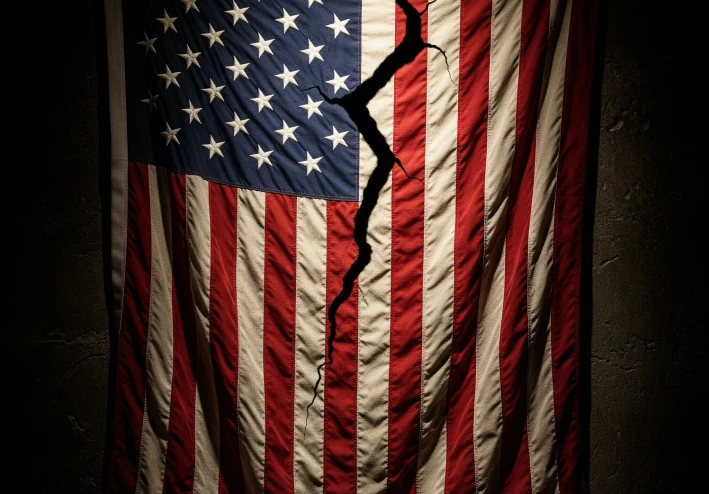
America in the Eye of the Storm: Internal Conflicts Deepen Divisions
America in the Eye of the Storm: Internal Conflicts Deepen Divisions
The United States of America finds itself, in mid-2024 and with the ongoing policy debates shaping 2025, at a historic crossroads. Internal conflicts are intensifying, and societal and political divisions are deepening. This is no longer just about traditional partisan disagreements; it has transformed into a profound polarization that strikes at the core of American identity, threatening to erode the nation's social and democratic fabric.
Heightened Political Polarization:
Political polarization is one of the most prominent features of the current American landscape. As presidential elections approach, or in the wake of their fallout, the battle between the two major parties, Democrats and Republicans, intensifies not only over policies but also over values and visions for the country's future. This polarization is evident in:
- Legislative Gridlock: The difficulty of reaching consensus in Congress on fundamental issues such as the budget, immigration, and healthcare leads to political stagnation, affecting the government's ability to function effectively.
- Extreme Partisan Rhetoric: Public discourse has become an arena for intense polarization, where the opposing side is often demonized and portrayed as a threat to American values. This rhetoric fuels division and makes it difficult to find common ground.
- The Role of Media and Social Media: Biased media outlets and social media platforms contribute to reinforcing "echo chambers," where individuals are exposed to information that confirms their existing beliefs, making it harder to understand opposing viewpoints and deepening the divide.
Key Contentious Issues:
Numerous issues are fueling internal conflicts in America, including:
- Immigration and Borders: The issue of immigration, especially at the southern border with Mexico, remains one of the most controversial. Views differ radically between those advocating for stricter policies to curb illegal immigration and those emphasizing migrants' rights and the need for comprehensive immigration reform. This divergence leads to continuous tensions between federal states and the central administration.
- Abortion Rights: Following the Supreme Court's decision to overturn Roe v. Wade, abortion has become a state-by-state issue, leading to a deep divide between states that ban or severely restrict abortion and those that protect it. This issue sparks widespread protests and is considered one of the most significant social issues impacting voters.
- Gun Control: With the increasing number of mass shootings, debates over gun laws are reignited. One side calls for stricter gun control to reduce violence, while the other defends the constitutional right to bear arms and rejects any further restrictions.
- Economy and Inflation: Although some economic indicators have improved, high living costs and inflation remain a major challenge for many Americans. Parties clash over the best ways to address these challenges, with differing views on the government's role in the economy, public spending, and taxation.
- Racism and Social Justice: Issues of racism and racial inequality continue to pose a significant challenge in American society. Debates over police reform, criminal justice, and systemic discrimination persist, fueling social tensions and widespread protests.
- Federal vs. State Power: There is an ongoing struggle over the extent of federal government authority versus state authority, especially given an administration that seeks to rebalance power towards the central government on certain issues, while some states strongly reject this.
A Cloudy Future:
Amidst this complex landscape, the United States faces a real challenge in restoring its cohesion. Addressing these conflicts requires intensive efforts from political and community leaders to foster dialogue, find common ground, and rebuild trust in democratic institutions. As Americans grapple with these internal challenges, the world watches closely, aware that the stability of the world's leading power directly impacts global peace and security.
America in the Eye of the Storm: The Tide of Internal Conflicts Sweeps Through the Social Fabric
The United States of America, in this mid-2024 period, finds itself surrounded by internal storms threatening to tear apart its social and political fabric. The division is no longer merely a seasonal partisan phenomenon; it has become deep-seated and entrenched, touching every aspect of American life, from politics and economics to culture and values. These escalating conflicts, intensified by approaching major electoral cycles and their repercussions, paint a picture of a nation struggling to find common ground among its disparate components.
Political Polarization as Both a Pull and Push Factor:
The most prominent feature of the American scene is the sharp political polarization between the Republican and Democratic camps. These divisions extend beyond mere differences in economic or social policies, reaching fundamental disagreements about the definition of American identity, the role of government, and the nation's future. Each side perceives the other as a threat to the foundational values upon which the nation was built, making compromise or cooperation almost impossible.
- Electoral Debates: As presidential and midterm elections draw near, the intensity of campaigns escalates. Competition often transforms into fierce battles characterized by personal attacks and incitement, rather than focusing on substantive issues.
- Legislative Division: This polarization is clearly reflected in Congress, where it is difficult for the two parties to agree on fundamental legislation. This leads to a "legislative paralysis" that hinders progress on many vital files, from the federal budget to immigration reform.
Social and Economic Issues Fueling Division:
A range of social and economic issues serve as fuel for these internal conflicts, notably:
- Immigration: Immigration, especially undocumented immigration across the southern border, remains a key point of contention. States differ in their policies towards immigrants, leading to tensions between local governments and the federal government. While some view open borders as a threat to national security, others emphasize the humanitarian and economic aspects of immigration.
- Abortion Rights: Since the Supreme Court's decision to overturn the landmark Roe v. Wade ruling, abortion has become one of the most controversial issues, with states battling between imposing strict restrictions or outright bans on abortion, and protecting it as a constitutional right.
- Racism and Racial Justice: Despite progress made, issues of racism and racial inequality continue to be open wounds in American society. These issues come to the forefront in discussions about police brutality, criminal justice reform, and systemic discrimination.
- Economy and Inequality: Despite overall positive economic indicators, high inflation and rising living costs continue to strain the pockets of the middle and lower classes. This economic disparity causes widespread frustration, fuels a sense of injustice, and intensifies demands for greater government intervention or radical changes in economic policies.
- Gun Rights: After every mass shooting incident, intense debates about firearm laws resurface. One side advocates for stricter gun control to reduce violence, while the other insists on the constitutional right to bear arms and rejects any attempts to restrict this right.
- Cultural War: American conflicts extend beyond politics to include a "cultural war" over issues such as education, LGBTQ+ rights, and the role of religion in public life. These issues, which touch upon deep personal values, are often a source of intense tension between different communities.
Challenges for the Future:
The continuation of these internal conflicts poses immense challenges for the United States. American democracy, long considered a global model, faces a real test of its ability to overcome divisions and find solutions that serve all its citizens. The need for constructive dialogue, responsible leadership, and the ability to find common ground has never been more urgent, not only for America's internal stability but also for its role in a turbulent global landscape.































